Abstract
Accelerating the innovation and development of the Industrial Internet Platform is inevitably necessary for the integration of new-generation information technology and the manufacturing industry. It is also the key point for promoting the construction of manufacturing power and network power. In this paper, based on the comprehensive analysis of the relevant problems of China’s Industrial Internet Platform development monitoring, the development index of the Industrial Internet Platform is designed. Taking a typical domestic Industrial Internet Platform as an example, the development index of the Industrial Internet Platform in 2018, 2019, and 2020 are comprehensively calculated in this paper. The results show that China’s Industrial Internet Platform is rapidly growing in many aspects, such as industrial equipment cloud and industrial APP. There is a large space for improving the industrial knowledge accumulation reuse and the application promotion of small/medium-sized enterprises. The results in this paper can provide scientific suggestions and practical references for the government, enterprises, scientific research institutions, which is of great significance in promoting the healthiness and sustainability of the Industrial Internet Platform.
1. Introduction
1.1. Research Background
As the fourth Industrial Revolution, the Industrial Internet or Industry 4.0 has attracted great interest from industry and academia due to the recent rise of exponentially growing technologies (e.g., Big Data [1], cloud computing [2], networks [3], artificial intelligence [4], etc.). The Industrial Internet has the potential to bring profound changes to traditional industries, such as manufacturing, aviation, rail transit, medical treatment, power generation, oil and gas development, etc. As the core of the Industrial Internet, the Industrial Internet Platform is a significant carrier to promote the deep integration of a new generation of information technology and manufacturing industry, as well as vital support for accelerating the development of the comprehensive digitalization, networking, and intelligent transformation of the manufacturing industry. In November 2017, the State Council of China issued the Guidance on Deepening the “Internet+ Advanced Manufacturing” Development of Industrial Internet. Thereafter, China’s Industrial Internet innovation and development strategy were fully launched [5]. With the endeavors of all society, a new pattern of platform-based integral development has evolved at an accelerated pace, while the development of the Industrial Internet Platform has reached a strategic window period for large-scale expansion.
As industrial capital has swarmed in this area, problems like blind investment, repeated construction, and mismatched resources have gradually emerged in this background. In addition, although there are many challenges in the development process of the Industrial Internet, These potentials can be brought into full play only the challenges can be solved. For example, an Industrial Internet Platform needs to be designed to have stringent performance and reliability requirements. When performing critical functions, an Industrial Internet Platform needs to be designed to have strict performance requirements, such as stability, accuracy, and resistance to extreme environments and long-term operation. Therefore, in the implementation of the Industrial Internet, security has become a huge challenge and is still being explored. Thus, how to scientifically and methodically regulate the healthy development of an Industrial Internet Platform has become a crucial issue of great concern to China and various industries, and the key point is how to get scientific monitoring of the development level of an Industrial Internet Platform.
Starting from the development of an Industrial Internet Platform, this paper puts forward an index system for monitoring and evaluating the development of an Industrial Internet Platform and again introduces the Fixed Base Index method to calculate the evaluation results. The research results of this paper can not only provide guidance for the healthy development of an Industrial Internet Platform but also provide suggestions for the decision-making of relevant departments.
1.2. Related Works
The research on the Industrial Internet mainly focuses on the infrastructure and the evaluation of the implementation of the Industrial Internet. Specifically, in the research on the infrastructure of the Industrial Internet, the Industrial Internet Consortium (IIC) [6] and the Alliance of Industrial Internet (AII) [7] have successively put forward an Industrial Internet reference framework suitable for their own national conditions. Wang et al. [8] proposed an IIP collaboration architecture called Industrial operating system (Ind-OS), which provides a better collaborative enterprise information system environment for manufacturing systems. Yang et al. [9] focused on the role of 5G in the Industrial Internet and proposed the technical architecture of 5G Industrial Internet edge computing. The implementation evaluation of the Industrial Internet is also a key area of Industrial Internet research, and many research institutions and researchers [10,11] have carried out research on it. For example, Wang et al. [12] proposed an attack capability evaluation method based on attack graphs and maximum traffic to solve the problem of finding complex paths in the Industrial Internet. Zhang and Ming [13] have given a general model and reference architecture of the Industrial Internet. Radanlieva et al. [14] focused on the economic impact assessment of the Internet of things and its associated network risks. Adamsky et al. [15] proposed a security framework to properly manage vulnerabilities and respond to threats in a timely manner. There is a lot of research in other areas related to the Industrial Internet, such as digital transformation [16], the integration of industrialization and information [17], and intelligent supply chain [10,11,18], and these studies have also promoted the development of Industrial Internet. Besides, the industry and academia have carried out a series of studies in the fields related to the Industrial Internet. For example, the industrial Internet of things references architecture released by Industrial Internet Consortium [10], and the “Industrial Internet Maturity Assessment White Paper” issued by the China Industrial Internet Industry Alliance [19] evaluated the industrial Internet maturity. Resende et al. [20] and Contreras-Masse et al. [21] put forward the evaluation and guidance scheme of the Industrial Internet of Things in terms of prediction, methods, and standards, respectively. The Aachen University of Technology [22] assessed the capacity of enterprise industry from four aspects, and then the Economic Development Board of Singapore and the Southern German Group [23] collaborated to conduct a similar study. Deloitte partnered with TM Forum [24] to assess the digital capabilities of the enterprise. The recent research is that Sui et al. [25,26] and Marelli et al. [27] have also proposed methods to evaluate the attacks on cyber-physical systems.
Based on the relevant research studies of domestic and overseas, it is obvious that most of the studies focus on the reference architecture, maturity model, and evaluation index systems of Industrial Internet related fields, few focus on the study of long-term and continuous tracking and monitoring of Industrial Internet Platform development, and research and practice from the perspective of a statistical index is still blank. In order to better grasp the development trend of the Industrial Internet and give full play to the role of Industrial Internet Platform in supporting industrial development, it is urgent to develop and release a systematic index representing the development status and evolution trend of Industrial Internet Platforms, dynamically track the development trend of the platform, accurately lock the platform, enhance the key points and accurately measure the value effect of the platform, so as to help the healthy and sustainable development of Industrial Internet Platform Exhibition.
It should also be noted that the Fixed Base Index method used in this paper is a mature evaluation method. Fixed Base Index can reflect the long-term dynamics of social and economic phenomena and the process of their development and changes. Many scholars have gradually begun to pay attention to the application of the Fixed Base Index method. For example, Hu and Ma [28] summarized the advantages and disadvantages of the existing Fixed Base Index method and analyzed the development trend of the Fixed Base Index method. In the existing literature research, the Fixed Base Index method has been applied to the research on the development trend of a variety of social industries, such as industry development trend research [29], technological innovation effectiveness research [30], and national economic accounting [31], and so on. Liu et al. [32] used the Fixed Base Index method to study the empirical problem of the relationship between coal price and supply and demand, in which the industrial price index of coal was taken as the base, and on this basis, the relationship between Fixed Base Index was calculated, and the final result was obtained. Stacho et al. [33] selected a questionnaire survey from 2013 to 2017, studied the relationship between the focus of employees’ organization in education and the education provided by effectiveness assessment, and used fixed base indicators to evaluate the positive changes in time of the selected attributes. Based on the analysis of the existing literature, it was found that the Fixed Base Index method is relatively mature, so it is reasonable and meaningful to apply the Fixed Base Index method to the design and monitoring of the Industrial Internet development platform.
2. The Development Level of Industrial Internet Platform
The construction and application of an Industrial Internet Platform involves all aspects of the production and operation of an enterprise, and its development level monitoring is a challenging and intricate system project. As the Chinese Industrial Internet Platform accelerates its development towards practice, how to monitor the development level of Industrial Internet Platform comprehensively, precisely, and dynamically is of great significance. Presently, the monitoring of the Industrial Internet Platform level still needs to focus on solving the following problems.
2.1. The Monitoring Target for the Development Index of Industrial Internet Platform
Industrial Internet Platform is an intricate system covering enterprise strategy, technology, organization, and process, which needs to adopt scientific methods to continuously monitor the development level of Industrial Internet Platform, and it is vital to building a multi-dimensional monitoring target system. The construction of monitoring target system of an Industrial Internet Platform should be carried out at least from two aspects of the key competencies and value benefit of Industrial Internet Platform, and the key elements such as industrial equipment connection, industrial mechanism model, industrial APP development, platform application promotion and value benefit ought to be considered.
2.2. Data Samples on Industrial Internet Platform
Obtaining comprehensive, complete, and high-quality data samples is an important prerequisite for monitoring the development level of an Industrial Internet Platform. Numerous Industrial Internet platforms’ corporate data is needed to support the monitoring of the development level of Industrial Internet Platforms, which still exists the following problems. Firstly, many Industrial Internet Platform enterprises did not store platform construction and operation statistical data, resulting in unobtainable data. Secondly, considering the data security and technical confidentiality, platform enterprises retain the data locally through privatization deployment, leading to ineffectively statistical relevant data. Lastly, due to the lack of a uniform standard, it is difficult to assess the authenticity of index data, such as the quantity of industrial equipment connections, the quantity of industrial mechanism models, and the industry coverage, while the identification cost is too high.
2.3. Long-Cycle and Continuous Dynamic Monitoring for the Development Index of Industrial Internet Platform
Since the Industrial Internet Platform is newly emerging, the development of an Industrial Internet Platform in China is still in the exploration stage of deep excavating to practice. Since 2018, most enterprises have not retained relevant statistical data at the beginning of the construction of an Industrial Internet Platform, while many enterprises have only started to invest in the construction and application of the platform in the past year. The number of platform enterprises that can provide relatively sufficient, accurate, and factual data in China is very limited, which is a big obstacle to the long-term, periodic, and continuous dynamic monitoring of Industrial Internet Platform.
3. Design Method for the Development Index of Industrial Internet Platform
For a long time, the community has usually used a statistical index method to monitor the development level and trends of complicated things with similar characteristics as an Industrial Internet Platform. Typical applications include Purchasing Manager’s Index (PMI) in the production field, Consumer Price Index (CPI) in the economic field, and Stock Index in the finance field [31]. Fixed Base Index is a statistical index used to monitor the dynamic long-term development and changes of specific things. The index follows that the comparative base period of an index in each period is the same fixed period, in which the index series are compiled in chronological order. Moreover, it usually sets a fixed base period and base period index and uses the index of the reporting period to characterize the change and development trend of monitoring objects in the reporting period relative to the base period [34]. This paper uses the fixed index method to monitor the development index of an Industrial Internet Platform. On the one hand, the development of an Industrial Internet Platform is a process of dynamic optimization and iterative evolution. The chronicity, dynamics, and sustainability characteristics of the Fixed Base Index method are especially suitable for development index monitoring of an Industrial Internet Platform. On the other hand, in order to make a clearer comparative analysis of the development level of Industrial Internet Platform in each stage, the design concept of Fixed Base Index in each period to compare the base period can be imitated, and take 2018 as a reference to monitor the development level of Industrial Internet Platform in each stage. The development index of an Industrial Internet Platform aims to periodically measure and continuously track and monitor the development trend, key features, and value effectiveness of an Industrial Internet Platform. It can also present the overall trend of platform development and the development level of various sub-fields in multiple dimensions. Research on the design, monitoring, and practice of the development index of an Industrial Internet Platform is of great significance to promote the sustainable and healthy development of an Industrial Internet Platform in China.
4. The Fixed Base Index Method for the Development Index of Industrial Internet Platform
To realize the comprehensive, objective, dynamic and efficient monitoring of the development level of an Industrial Internet Platform, combined with the actual demand and stage of the development of an Industrial Internet Platform in China, this paper used the Fixed Base Index method to design the development index of an Industrial Internet Platform. Combining the actual condition of Industrial Internet Platform corporate data samples, this paper analyzes and constructs a monitoring target system that can objectively and comprehensively reflect the development level of China’s Industrial Internet Platform and a series of platform development indexes. Based on the core concept of Fixed Base Index, this paper gives the calculation method of the development index for an Industrial Internet Platform, which is shown in the following context.
4.1. Monitoring Target System
This paper selects a number of key indicators to characterize the construction and application of the platform to form a target system of development index monitoring of Industrial Internet Platform as shown in Figure 1, including two primary indicators including crucial capabilities of the platform and value effectiveness of the platform, five secondary indicators and 14 information collection items. The crucial capabilities of the platform are mainly evaluated from three aspects: industrial equipment connection, industrial equipment mechanism, and industrial APP development. The evaluation of these three aspects also depends on the information collection items, and these three aspects depend on each other and complement each other. The value effectiveness of the platform is mainly evaluated from two aspects: value benefit of the platform and application promotion of the platform, and the evaluation of these two aspects also depends on the information collection items, and these three aspects also complement each other. In addition, the evaluation of crucial capabilities of the platform is the basis of the evaluation of the value effectiveness of the platform, and the evaluation of value effectiveness of the platform is the expansion of the evaluation of crucial capabilities of the platform.

Figure 1.
Monitoring target system of the development index of Industrial Internet Platform.
4.1.1. Key Capability Indicators of Industrial Internet Platform
The key capability index of the platform aims to represent the supply level of the core capability of an Industrial Internet Platform. The index mainly involves three secondary indexes, including industrial equipment access, industrial mechanism model and development, utilization of industrial APP and nine information collection items. Among them, the industrial equipment access index includes three information collection items: quantity of industrial equipment access, type of industrial equipment access, and quantity of compatible industrial protocols, which are used to reflect the connection of platform resources. The index of industrial mechanism model includes two information collection items: quantity of industrial mechanism models and type of industrial mechanism models, which are used to designate the accumulation and reuse of industrial knowledge on the platform; The index of industrial APP development includes four information collection items: quantity of industrial APP, the quantity of industrial killer-APP subscribed, the number of registered developers and quantity of active developers, which shows the overall scale and development quality of the platform’s industrial APP. The detailed key capability index design and collection items description is shown in Table 1.

Table 1.
Key capability index design and collection items description of Industrial Internet Platform.
4.1.2. Value Effectiveness Index of Industrial Internet Platform
The platform value effectiveness is primarily used to characterize the application and benefit of an Industrial Internet Platform, which includes two secondary indexes of platform application and promotion, platform value benefit, and five information collection items.
Among them, the platform application and promotion index includes the number of registered enterprises, the number of service enterprises, the number of covered industries, focusing on the monitoring of the platform application range. The platform value benefit includes two collection items: cumulative main business revenue and ROI, which aims to monitor the platform value from the perspective of platform income. The detailed platform value effectiveness indicators and collection items are shown in Table 2.

Table 2.
Value Effectiveness Index Design and Collection Item Description of an Industrial Internet Platform.
4.2. Series Index
Based on the monitoring target system of platform development index, this paper designs a series of platform development indexes, including the overall platform development index, which can monitor the overall level and condition of Industrial Internet Platform development, as well as industrial equipment access index, industrial knowledge accumulation index, industrial APP development index, platform application promotion index, and platform value benefit index, which can realize the monitoring of the development level of Industrial Internet Platform subdivision field. The detailed description of each series index is shown in Table 3.

Table 3.
Series Development Index of Industrial Internet Platform and the Description.
4.3. Typical Samples
The sample platforms of the development index of Industrial Internet Platform selected from the 2019 cross-industry cross-domain Industrial Internet Platform issued by the Ministry of Industry and Information Technology (see Table 4), which have a great significance of industry representation and scientific representation significance. The selected sample platforms have strong resource agglomeration, application service, and sustainable development ability and are typical benchmarks for Industrial Internet technology innovation and industrial application. The sample platform is connected to nearly 14 million industrial equipment, while there are nearly 20 service industries of sample platforms, covering aerospace, shipbuilding, equipment manufacturing, household appliances, electronics, steel, chemical industry, pharmaceutical, and other fields. Sample platform docking dozens of domestic provinces and cities with strong regional service support capabilities.

Table 4.
Development Index Series and Description of Industrial Internet Platform.
4.4. Calculation Method
Fixed Base Index method is used as the calculation method of development index of Industrial Internet Platform, which includes the determination of base period index, collection item processing, classified index calculation, weight setting, and aggregative index calculation, etc.
4.4.1. Determination of Base Period Index
We chose 2018 as the base period of development index monitoring of Industrial Internet Platform with the practical development situation of Industrial Internet Platform in China. The base period index values of the total development index of Industrial Internet Platform and each sub-index were set to 100.
4.4.2. Process Collection Item
Considering the influence of the information collection item data by each platform on the development index of the platform, combining the construction and promotion practice of Industrial Internet Platform, proceed data preprocessing such as: eliminating the abnormal value, filling the missing values, and verifying the information collection item data of the index system.
4.4.3. Sub Index Calculation
- First item; Summing the information collection items of the five sub-index corresponding to each sample platform in 2018, 2019, and 2020, then obtained Snij, the sum of information collection items for each year corresponding to each sub-index. In which:N represents time, N = 0 corresponds to 2018; N = 1 corresponds to 2019, and so on.i represents the category of sub-index information collection item. I = 1 corresponds to the Industrial equipment access index; I = 2, corresponds to the Industrial knowledge accumulation index; I = 3, corresponds to the Industrial APP development index; I = 4, corresponds to the Platform application promotion index; I = 5 corresponds to the Platform value benefit index.j is the category of information collection items to which each sub-index belongs, and j = 1 corresponds to the information collection item of Quantity of industrial equipment access; j = 2, corresponding to the quantity of compatible industrial protocols and so on.
- Taking 2018 as the base period, calculate the index value Knij of information collection items corresponding to each sub-index in each year, respectively. j is the number of information collection items corresponding to each sub-index. The calculation formula is as follows:
- 2018’s base period index is 100, and the sub-index value cnij of each year is calculated as follows:where Cn1—Industrial equipment access index of the nth year; Cn2—Industrial knowledge accumulation index of the nth year; Cn3—Industrial APP development index of the nth year; Cn4—Platform application promotion index of the nth year; Cn5—Platform value benefit index of the nth year.
4.4.4. Aggregative Index Calculation
The following formula is used to calculate the total index of Industrial Internet Platform development:
where wi is the weight of each sub-index. Considering the comprehensive influence of industrial equipment access, industrial knowledge accumulation, industrial APP development, platform application promotion, and platform value benefit on the overall platform development index of the Industrial Internet Platform, this paper uses the equal weight method to calculate the aggregative index.
5. Analysis for the Development Index of Industrial Internet Platform
In this paper, the Fixed Base Index method was used to collect, process, and calculate the relevant data of the development index system of the top ten cross-industry and cross-domain Industrial Internet Platform in China in 2018, 2019, and 2020. The development index values of China’s Industrial Internet Platform in the past three years are obtained respectively. Based on the analysis of the measured results, it can be found that the overall development level of China’s Industrial Internet Platform shows a good trend of accelerated improvement. It presents different characteristics in the aspects of industrial equipment connection, industrial knowledge accumulation, industrial APP development, platform application promotion, and platform value benefit.
5.1. Trend of Rapid Growth
Industrial equipment connection, industrial APP development, and platform value benefits have become the main driving forces for the development of the platform. As shown in Figure 2, as of June 2020, the development index of an Industrial Internet Platform reached 172.4, accelerating at an average annual growth rate of more than 30 percent in the past two years. In terms of the overall situation, the development index of an Industrial Internet Platform reached 123.8 and 172.4 respectively in 2019 and 2020, with an average growth rate of 31.3% in the past three years. In terms of sub-index, the industrial equipment connection index has developed the fastest, with an average annual growth rate of 58.7% since 2018. In 2020, the industrial equipment connection index, the industrial APP development index, and the platform value benefit sub-index reached 251.9, 179.5, and 169.5 respectively, with a rapid growth significantly higher than the overall platform development index in the past three years, which has become the main driving force for the innovation and development of the Industrial Internet.
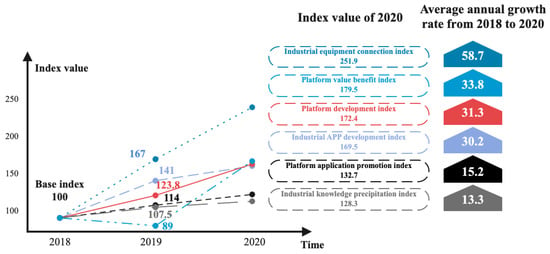
Figure 2.
Development Index and Segmentation Index of Industrial Internet Platform in 2018–2020.
5.2. The Cloud on Industrial Equipments
The mainstream industrial agreements achieve comprehensive coverage. Instruments, power equipment, electronic equipment have become the main force of the connection of industrial equipment on the cloud. Industrial enterprises connect equipment to all kinds of Industrial Internet Platform carry out comprehensive collection, aggregation, analysis, and the application of equipment data, and realize online monitoring of equipment status, remote intelligent maintenance, and production optimization, which can obviously enhance the competitiveness of enterprises. As shown in Figure 3, the industrial equipment connection index reached 251.9 in 2020, with an average annual growth rate of 58.7% in the past two years, nearly twice that of the development index of an Industrial Internet Platform. As shown in Figure 4, among the ten major platform industrial equipment, instrumentation accounts for the highest proportion of cloud types, accounting for 28.9%, followed by power equipment, electrical and electronic equipment, accounting for 16.6% and 12.8%, respectively, and they become the main force in the cloud on industrial equipment. In the aspect of cloud protocol adaptation on industrial equipment, the current ten platforms support the analysis and access of many types of industrial protocols, such as industrial fieldbus, industrial ethernet, and industrial wireless, to achieve comprehensive coverage of mainstream industrial protocols such as Modbus, PPI, MPI, CanBus, InterBus, OPC-UA, PROFIBUS, and so on.
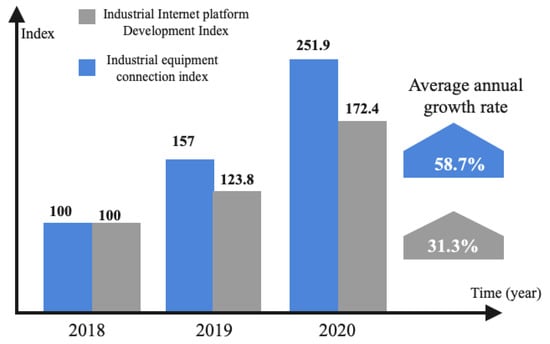
Figure 3.
Change trend of industrial equipment connection level in 2018–2020.
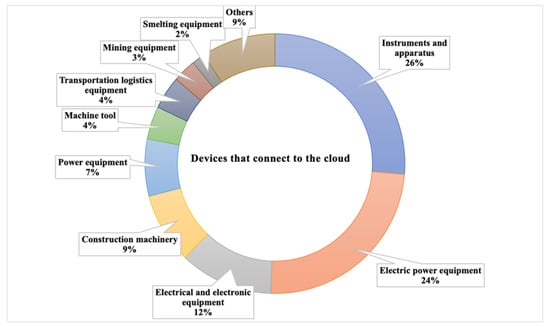
Figure 4.
Distribution of industrial equipment connected to the cloud in 2020.
5.3. The Accumulation Level of Industrial Internet Platform
The lack of development ability of the data algorithm model restricts the development of an Industrial Internet Platform to a deeper level. At present, the industrial mechanism model with valuable industry knowledge and rich experience has become the key for industrial enterprises to carry out digital transformation, and it is also an important basis for iterative reuse of industrial knowledge and industrial APP development. The industrial knowledge accumulation index reached 128.3 in 2018, and its growth trend is shown in Figure 5. From 2018 to 2020, the average annual growth rate of the industrial knowledge accumulation index was only 13.3%, which is less than half of the growth rate of the development index of an Industrial Internet Platform. It reflects the lack of capacity of the platform in the development and application of industrial mechanism models. Further analysis, among the industrial mechanism models accumulated by the top ten platforms in 2020, the business process model, industry mechanism model, R&D simulation model, and data algorithm model accounted for 38%, 29%, 18%, and 15%, respectively. Among them, the data algorithm model accounts for the lowest proportion, reflecting the lack of ability of enterprises in data modeling and algorithm development, which restricts Industrial Internet Platform to develop to a deeper level.
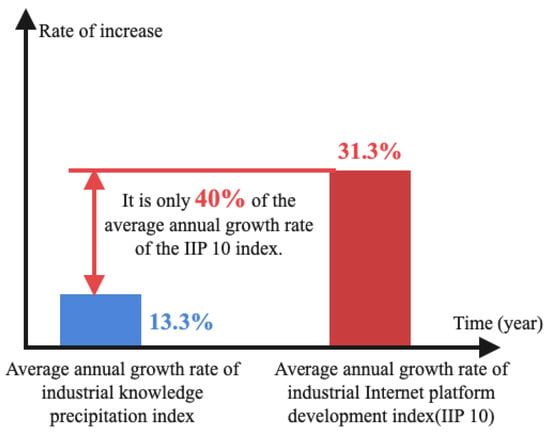
Figure 5.
Growth trend of platform industrial knowledge accumulation index from 2018 to 2020.
5.4. The Development of Industrial Internet Platform APP
Operation management, equipment operation and maintenance, manufacturing, and other types of APP are the current hot spots of platform development. In 2020, the industrial APP development index reached 169.5, with an average annual growth rate of 30.2% in the past two years. Industrial APP of operation management, equipment operation and maintenance, manufacturing, and other types exceeded 60% of the total industrial APP. Industrial APP is the core of industrial value and the direct embodiment of the value creation of an Industrial Internet Platform. Platform-related enterprises and service providers have carried out industrial APP development and application practice. At present, the average number of industrial APP in the top 10 platforms has reached 5927, more than double that in 2018, and has grown rapidly at an average annual growth rate of 56 percent in the past three years, as shown in Figure 6. At the same time, statistics on the category distribution of industrial APP of the top ten platforms showed that the development of platform industrial APP was mainly focused on the production and operation value of enterprises. Among them, the top three types of industrial APP, such as operation and management, equipment operation and maintenance, and manufacturing, account for 26.1%, 24%, and 16.9%, respectively, accounting for a total of 67.0%, which has become a hot field of platform development, as shown in Figure 7.
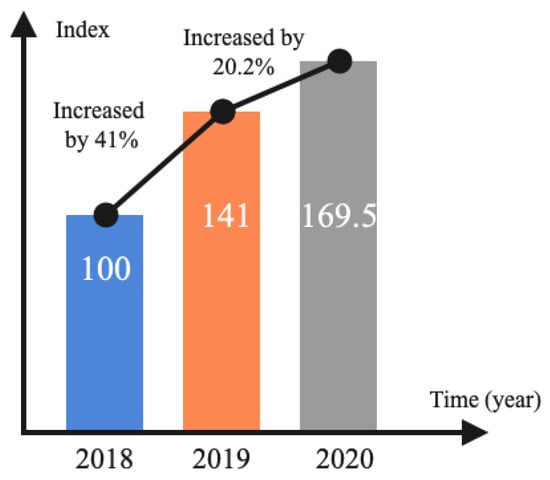
Figure 6.
Change trend of platform industry APP development index in 2018–2020.
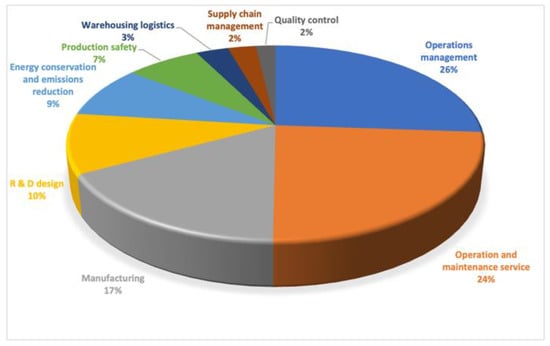
Figure 7.
Distribution of APP types in the top ten platform industries in 2020.
5.5. Expansion to the Vast Number of Enterprises and Vertical Industries
Small and medium-sized enterprises are the “Virgin Land” for Industrial Internet platforms to be developed urgently. The platform application promotion index reached 132.70 in 2020, with an average annual growth rate of 15.2% in the past two years. The lack of service to small and medium-sized enterprises is one of the important factors restricting the promotion of the platform. To promote industrial enterprises on the platform, the use of the platform has become the key to the practice of the Industrial Internet. As shown in Figure 8, the average annual growth rate of the platform application promotion index from 2018 to 2020 is 15.2%, which is less than half of the average annual growth rate of the development index of Industrial Internet Platform. There is still plenty of room for an Industrial Internet Platform to develop to a deeper level in vertical industries and value fields. At present, as an important support of our national economy, the number of small and medium-sized enterprises has exceeded 30 million, small and medium-sized enterprises have created more than 50% of taxes, more than 60% of GDP, 70% technological innovation, and 80% of urban labor employment, accounting for 99% of the main market body [35]. It is the absolute main body of Industrial Internet Platform service and the key to the deep ploughing of the platform. As shown, among the top 10 double cross-platform service enterprises, small and medium-sized enterprises account for an average of only 17.8%. Main customers served by platform enterprises are still large-scale enterprises. Serving the majority of small and medium-sized enterprises is not only the key to the development of the platform in the future but also an important opportunity for the platform to achieve large-scale innovation and development.
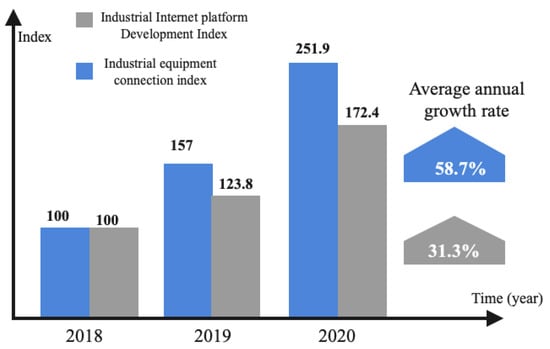
Figure 8.
Change trend of platform application promotion index from 2018 to 2020.
5.6. The Potential Counter-Trend Development
Industrial Internet Platform has gradually entered the explosive growth period after the initial investment stage. In 2020, under the background of the spread of the COVID-19 epidemic and the global economic downturn, China’s Industrial Internet industry bucked the trend, with the platform value benefit index as high as 179.5, double that of 2019 (as shown in Figure 9). It has become one of the important forces driving the recovery of the national economy. During the epidemic situation of COVID-19, platform-based products and solutions such as network collaborative office APP, flexible manufacturing of epidemic prevention materials, matching of supply and demand of medical materials, and remote maintenance of construction machinery played a significant role, which not only helped China’s epidemic prevention and control and resumption of production but also significantly improved the economic benefits of platform enterprises. In 2020, the cumulative business income of the top ten platform enterprises reached an average of 6.19 billion yuan, more than double that of 2019. At the same time, as shown in Figure 10, after platform enterprises began to increase the construction of Industrial Internet Platform in 2018, although the average business income of the platform decreased slightly in 2019, it officially entered the industrial development stage of value realization after a short adjustment period.

Figure 9.
Change trend of platform value benefit index from 2018 to 2020.

Figure 10.
Average business revenue of the top ten platforms from 2018 to 2020.
6. Conclusions
This paper focuses on the actual needs of the innovation and development of China’s Industrial Internet Platform and studies the design, monitoring, and practice of the development index of Industrial Internet Platform, which is of great significance to promote the sustained and healthy development of China’s Industrial Internet Platform. With the deepening of China’s Industrial Internet Platform, it is necessary to further improve the development index monitoring of an Industrial Internet Platform system according to the practical needs of the development of China’s Industrial Internet Platform in the future. First, continue to build and improve development index monitoring of an Industrial Internet Platform data platform, speed up the absorption and gathering of more high-quality platform enterprises and industry practices, continue to accumulate platform development data resources, and regularly carry out development index monitoring of an Industrial Internet Platform. The second is to make full use of the Internet of things, Big Data, blockchain, artificial intelligence, and other new-generation information technology to improve the collection, processing, analysis, and application efficiency of the monitoring data of the development index of Industrial Internet Platform, and to strengthen the monitoring platform’s ability in network information security to ensure the safe and efficient application of data. Third, cooperate with all parties to scientifically promote the construction and application of the platform and build a platform development monitoring system that serves different levels of the country, industry, region, and enterprises, so as to promote the high-quality development of China’s manufacturing industry.
Author Contributions
Index evaluation framework design, K.D. and J.L.; measurement of data, K.D. and Y.Z.; writing—original draft preparation, J.L., K.D. and Y.Z.; writing—review and editing, J.L. and K.D.; supervision, J.L. and Y.Z.; project administration, J.L. and Y.Z.; funding acquisition, J.L. All authors have read and agreed to the published version of the manuscript.
Funding
This research was funded by “The National Key Research and Development Program of China” under Grant 2018YFF0213700, “The National Key Research and Development Program of China” under Grant 2021YFB1715300, “The National Natural Science Foundation of China” under Grant 6217071254, “The 2018 Industrial Internet Platform Innovation and Development Program of China” (Development and promotion of standards for application capability and performance evaluation of industrial Internet platform).
Conflicts of Interest
The authors declare no conflict of interest.
References
- Wu, X.D.; Zhu, X.Q.; Wu, G.Q.; Ding, W. Data mining with big data. IEEE Trans. Knowl. Data Eng. 2014, 26, 97–107. [Google Scholar]
- Armbrust, M.; Fox, A.; Griffith, R.; Joseph, A.D.; Katz, R.H.; Konwinski, A.; Lee, G.; Patterson, D.A.; Rabkin, A.; Stoica, I.; et al. Above the Clouds: A Berkeley View of Cloud Computting; Department of Electrical Engineering and Computer Sciences, University of California: Berkeley, CA, USA, 2009; Tech. Rep. UCB/EECS-2009-28. [Google Scholar]
- Yick, J.; Mukherjee, B.; Ghosal, D. Wireless sensor network survey. Comput. Netw. 2008, 52, 2292–2330. [Google Scholar] [CrossRef]
- Russell, S.J.; Norvig, P. Artificial Intelligence: A Modern Approach; Pearson Education: Upper Saddle River, NJ, USA, 2009. [Google Scholar]
- State Council of the People’s Republic of China. Guidance on Deepening "Internet + Advanced Manufacturing Industry" and Developing Industrial Internet; State Council of the people’s Republic of China: Beijing, China, 2017.
- Industrial Internet Consortium Working Committees, Cambridge, MA, USA. The Industrial Internet of Things Volume G1: Reference Architecture. Available online: https://www.iiconsortium.org/IIRA.htm (accessed on 8 September 2021).
- Alliance of Industrial Internet, Beijing, China. White Paper of Industrial Internet Platform. Available online: http://www.aii-alliance.org/bps/20200302/827.html (accessed on 8 September 2021).
- Wang, J.; Xu, C.; Zhang, J.; Bao, J.; Zhong, R. A collaborative architecture of the industrial Internet platform for manufacturing systems. Robot. Comput. Integr. Manuf. 2020, 61, 101854. [Google Scholar] [CrossRef]
- Yang, X.; Shi, X.H.; Shen, Y.; Duan, H.B.; Zhu, X.T. Edge computing applications and technical architecture of 5G industrial Internet. Appl. Electron. Tech. 2019, 45, 25–33. [Google Scholar]
- Industrial Internet Consortium, Needham, MA, USA. IoT Security Maturity Model: Description and Intended Use. Available online: https://www.iiconsortium.org/pdf/SMM_Description_and_Intended_Use_V1.2.pdf (accessed on 9 September 2021).
- Cheng, Y.; Peng, J.; Gu, X.; Zhang, X.; Liu, W.; Zhou, Z. An intelligent supplier evaluation model based on data-driven support vector regression in global supply chain. Comput. Ind. Eng. 2020, 139, 105834.1–105834.11. [Google Scholar] [CrossRef]
- Wang, H.; Chen, Z.; Zhao, J.; Di, X.; Liu, D. A vulnerability assessment method in industrial Internet of Things based on attack graph and maximum flow. IEEE Access 2018, 6, 8599–8609. [Google Scholar] [CrossRef]
- Zhang, X.Y.; Ming, X.G. A comprehensive industrial practice for Industrial Internet Platform (IIP): General model, reference architecture, and industrial verification. Comput. Ind. Eng. 2021, 158, 107426. [Google Scholar] [CrossRef]
- Radanliev, P.; De Roure, D.C.; Nicolescu, R.; Huth, M.; Montalvo, R.M.; Cannady, S.; Burnap, P. Future developments in cyber risk assessment for the Internet of Things. Comput. Ind. 2018, 102, 14–22. [Google Scholar] [CrossRef]
- Adamsky, F.; Aubigny, M.; Battisti, F.; Carli, M.; Cimorelli, F.; Cruz, T.; Di Giorgio, A.; Foglietta, C.; Galli, A.; Giuseppi, A.; et al. Integrated protection of industrial control systems from cyber-attacks: The ATENA approach. Int. J. Crit. Infrastruct. Prot. 2018, 21, 72–82. [Google Scholar] [CrossRef]
- Berman, S.J. Digital transformation: Opportunities to create new business models. Strategy Leadersh. 2012, 40, 16–24. [Google Scholar] [CrossRef]
- Xu, Z.; Zhang, J.; Song, Z.; Liu, Y.; Li, J.; Zhou, J. A scheme for intelligent blockchain-based manufacturing industry supply chain management. Computing 2021, 103, 1771–1790. [Google Scholar] [CrossRef]
- Ruan, M. Pollution risk combination optimization control method for drinking water’s intelligent cold chain supply chain. Arab. J. Geosci. 2021, 14, 1–10. [Google Scholar] [CrossRef]
- Industrial Internet Industry Alliance. Industrial Internet maturity Assessment White Paper. Available online: https://www.miit.gov.cn/n973401/n5993937/n5993968/c6002364/part/6002369.pdf (accessed on 9 September 2021).
- Resende, C.; Folgado, D.; Oliveira, J.; Franco, B.; Moreira, W.; Oliveira-Jr, A.; Cavaleiro, A.; Carvalho, R. TIP4.0: Industrial Internet of Things Platform for Predictive Maintenance. Sensors 2021, 21, 4676. [Google Scholar] [CrossRef]
- Contreras-Masse, R.; Ochoa-Zezzatti, A.; García, V.; Perez-Dominguez, L.; Elizondo, M. Implementing a Novel Use of Multicriteria Decision Analysis to Select IIoT Platforms for Smart Manufacturing. Symmetry 2020, 12, 368. [Google Scholar] [CrossRef] [Green Version]
- IMPULS Foundation of VDMA. Industry 4.0 Readiness. Available online: https://industrie40.vdma.org/documents/4214230/26342484/Industrie_40_Readiness_Study_1529498007918.pdf/Ob5fd52l-9ee2-2de0-f377-93bdd01edlc8 (accessed on 12 October 2021).
- Singapore Economic Development Board. The Singapore Smart Industry Readiness lndex. Available online: https://www.gov.sg/-/sgpcmedia/media_releases/edb/press_release/P-20171ll3-l/attachment/The%20Singapore%20Smart%20Industry%20Readiness%20Index%20-%20Whitepaper_final.pdf (accessed on 12 October 2021).
- Deloitte. Digital Maturity Model Achieving Digital Maturity to Drive Growth. Available online: https://www2.deloitte.com/content/dam/Deloitte/globaVDocuments/Technology-Media-Telecommunications/deloitte-digital-maturity-model.pdf (accessed on 12 October 2021).
- Sui, T.; Mo, Y.; Marelli, D.; Sun, X.M.; Fu, M. The vulnerability of cyber-physical system under stealthy attacks. IEEE Trans. Autom. Control. 2020, 66, 637–650. [Google Scholar] [CrossRef] [Green Version]
- Sui, T.; Sun, X.M. The vulnerability of distributed state estimator under stealthy attacks. Automatica 2021, 133, 109869. [Google Scholar] [CrossRef]
- Marelli, D.; Sui, T.; Fu, M.; Lu, R. Statistical approach to detection of attacks for stochastic cyber-physical systems. IEEE Trans. Autom. Control. 2020, 66, 849–856. [Google Scholar] [CrossRef] [Green Version]
- Hu, G.Q.; Ma, P.C. Trend Determination and Application of Fixed-base Index Number. J. Henan Inst. Eng. 2010, 22, 31–33. [Google Scholar]
- Liu, B.; Jiang, G.Y.; Li, H.; Chen, J.D.; Wu, L.; Chen, Y.J. Scheme Design and Empirical Research on an Index System for Road Freight in Ningbo Region. Procedia Soc. Behav. Sci. 2014, 138, 223–232. [Google Scholar] [CrossRef] [Green Version]
- Wang, Z.L.; Lan, J.; Zhou, W.P.; Ning, W.U.; Tan, S.M. Researeh on Qingdao Science and Technology Innovation Index. Sci. Technol. Ind. 2018, 18, 79–83. [Google Scholar]
- Jiang, Y.S. Prediction Analysis on the Trend of the Producer Price index of China. Logist. Eng. Manag. 2014, 36, 101–102. [Google Scholar]
- Liu, X.; He, H.; Chang, J.; Ming, L. The Empirical Research of Relation Between Price and Supply and Demand of Coal in China. J. Syst. Sci. Inf. 2012, 10, 387–394. [Google Scholar]
- Stacho, Z.; Stachová, K.; Raišienė, A.G. Changes in approach to employee development in organizations on a regional scale. J. Int. Stud. 2019, 12, 299–308. [Google Scholar] [CrossRef] [PubMed]
- Cui, S.Q. Discussion on the evaluation method of economic and social coordinated development based on fixed base index. Stat. Res. 2011, 28, 65–66. [Google Scholar]
- Ministry of Industry and Information Technology: By the End of Last Year, the Number of Small and Medium-Sized Enterprises in China Had Exceeded 30 Million. Available online: https://news.sina.com.cn/o/2019-09-20/doc-iicezzrq7214185.shtml (accessed on 13 October 2021).
Publisher’s Note: MDPI stays neutral with regard to jurisdictional claims in published maps and institutional affiliations. |
© 2022 by the authors. Licensee MDPI, Basel, Switzerland. This article is an open access article distributed under the terms and conditions of the Creative Commons Attribution (CC BY) license (https://creativecommons.org/licenses/by/4.0/).